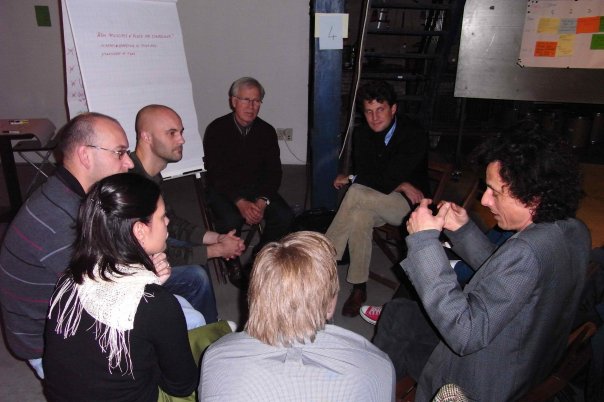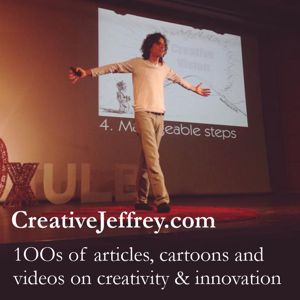
Let’s Bounce a Few Ideas Off Each Other
By Jeffrey Baumgartner
One of several aspects of creative thinking, that lead me to develop Anticonventional Thinking (ACT), is that the way a group of highly creative people naturally collaborate on idea development is very different to the approach you are supposed to take in brainstorming or using creative problem solving (CPS), which is a more elaborate and structured form of brainstorming. In brainstorming, of course, you are supposed to reserve judgement and welcome all ideas with the aim of producing a long list (or, often, a large number of sticky-notes) of ideas. Later, these ideas are reviewed critically in order to identify which ones to go further with. But criticism is forbidden until then.
However, in my experience as an artist and writer, when highly creative people want ideas for a project, they usually take a very different approach. They bounce ideas off each other with the aim of formulating a creative project (such as a script or a song) or contributing to a project that is in progress.
How Creatives Do It
For instance, imagine that you and I are bouncing ideas off each other for a film concept. The first thing we will do is look into our own minds for ideas. However, rather than simply shout out each idea, we think about it and decide whether or not it is interesting enough to propose. Ideas that are boring or uninteresting are not shared. And here is the first key difference between CPS and ACT: CPS states that you should keep no ideas to yourself and put everything you think of on the table, no matter how trivial or how bizarre. Most creative people do not want to waste their time with trivial or boring ideas – and so do not suggest them. However, they tend to embrace the unconventional and bizarre and so take pride in proposing such ideas. As a result, when highly creative people collaborate on developing ideas, they usually share far fewer than averagely creative brainstormers.
Back to our collaboration. Once I’ve suggested an idea, we both immediately consider it. If it might have potential, we develop it a bit. For instance, I suggest that we do a science fiction film about a private detective in the far future. You might immediately reject my idea saying that it is too much like X-Files and Men in Black. I can counter and explain why my idea is different to, and better than, those. This debate could go on for a while until we either agree to reject it or develop it more.
Developing an Idea with Further Ideas
In this case, we might now start thinking about the main character, the future that she inhabits and the kinds of crimes she investigates. Since we are both very creative, you can be sure there will be some wild ideas here. Nevertheless, in time we may find that we do not have sufficiently original ideas to turn this idea into a film. So, we set the idea aside, with at least one of us making notes about it in case we decide to explore the idea in the future. Then we think about ant suggest new ideas.
Perhaps you suggest a film, based on Romeo and Juliet, which takes place in a post-apocalyptic world. Once again, we work our way through a similar process.
Eventually, we will have a concept that we both agree upon. At this time, we can also agree on the next steps and who is responsible for each. We plan to meet again in a couple of days to compare notes and go further.
Here is another critical difference between brainstorming and the way highly creative people naturally collaborate. At the end of a brainstorm, we can expect to have a very large number of ideas that an individual or team will need to sift through in order to determine which idea or ideas merit further development. In the case of creative collaboration, we have a chosen idea and initial action to take.
You Do Not Need the Most Creative Idea; You Need an Actionable Idea Now
Brainstorming fans might argue that by not brainstorming every last possibility, we may have missed out on a more creative alternative. Frankly, I doubt this is the case. Moreover, I would further argue it does not matter. What matters is that we have a highly creative idea that we are already acting upon rather than a list of 50 ideas that needs to be reviewed.
As you can see, the artistic approach breaks just about every rule in brainstorming:
- Participants have purposely kept ideas to themselves – when the ideas are perceived as too conventional.
- Participants have criticised and debated each others’ ideas.
- Participants have made immediate judgements about ideas rather than reserving judgement for a later time.
Yet this approach, which I have incorporated into ACT is the approach highly creative people take when using creativity to solve problems or achieve goals. It is the approach I have usually taken myself and when working with others on creative projects.
Interestingly, I find that this is also a natural approach. If I suggest to another writer that we bounce ideas off each other to collaborate on a project, she will understand what I mean and we can get started immediately, without needing to put in place any brainstorming rules.
Where CPS Is Useful
Where does this leave CPS? I feel CPS is best when you need a large number of smaller, moderately creative ideas. For instance, once we have defined the basic concept of our film: the main characters, the key conflicts, the main settings, then we may want to brainstorm the details of our future scenarios (if we go with a science fiction film) because we would need a lot of ideas in order to create rich settings for our characters to live in. In this situation, a list of visual features in a futuristic landscape would be useful.
Yet, even when we “brainstorm” like this, evidence suggests that we will have more ideas and more creative ideas if we allow ourselves to criticise and debate ideas as they are proposed1.
So, when you want big, creative concepts, anticonventional thinking is the way to go. When you want a lot of smaller ideas, brainstorming (with modifications) is the way to go.
Footnote
- Matthew Feinberg, Charlan Nemeth (2008) “The ‘Rules’ of
Brainstorming: An Impediment to Creativity?” Institute for Research
on Labor and Employment Working Paper Series; University of California, Berkeley;
Paper iirwps-167-08 http://www.techrepublic.com/whitepapers/the-rules-of-brainstorming-an-impediment-to-creativity/2555083/post
(free registration required)
Recent Articles
Leading Diverse Teams
Filed under: Business Innovation
Diverse teams are more innovative and smarter than homogeneous ones. But, they are also harder to manager. Here are some tips. By Jeffrey Baumgartner -- Read the article...
Questions you should ask when an innovative project fails
Filed under: Business Innovation
You can learn a lot from the failure of an innovative project, but you need to ask the right questions. Here are those questions. By Jeffrey Baumgartner -- Read the article...
Unmarketing the Competition
Filed under: Business Innovation
A look at creative, but unethical dirty trick marketing campaigns designed to damage the competition By Jeffrey Baumgartner -- Read the article...
Imaginativefulness and the Fisherman
Filed under: Creativity
What does a fisherman wearing a cycling helmet have to do with imaginativefulness? Quite a lot, it seems. By Jeffrey Baumgartner -- Read the article...
Actually, Criticising Ideas Is Good for Creativity
Filed under: Creativity
People have long assumed criticising ideas in a brainstorm inhibits creativity. Research and experience shows that is wrong By Jeffrey Baumgartner -- Read the article...
Imaginativefulness
Filed under: Creativity
Imaginativefulness is a state of heightened imagination in which your mind allows thoughts, memories and ideas to play with each other freely. By Jeffrey Baumgartner -- Read the article...
Why and How to Exploit Alternative Uses for Your Products
Filed under: Business Innovation
Discovering new ways customers use, misuse and could use your products can inspire innovation. Jeffrey Baumgartner explains. By Jeffrey Baumgartner -- Read the article...
The Cost of Not Innovating
Filed under: Business Innovation
If your company fails to innovate, you pay a steep price in terms of loss of leadershop, tight margins, missed opportunities and more. By Jeffrey Baumgartner -- Read the article...
Don't Trust the Status Quo
Filed under: Creativity
Jeffrey Baumgartner has never trusted the status quo. He explains why this is so and why you should also not trust the status quo By Jeffrey Baumgartner -- Read the article...
Index of all creative articles...




